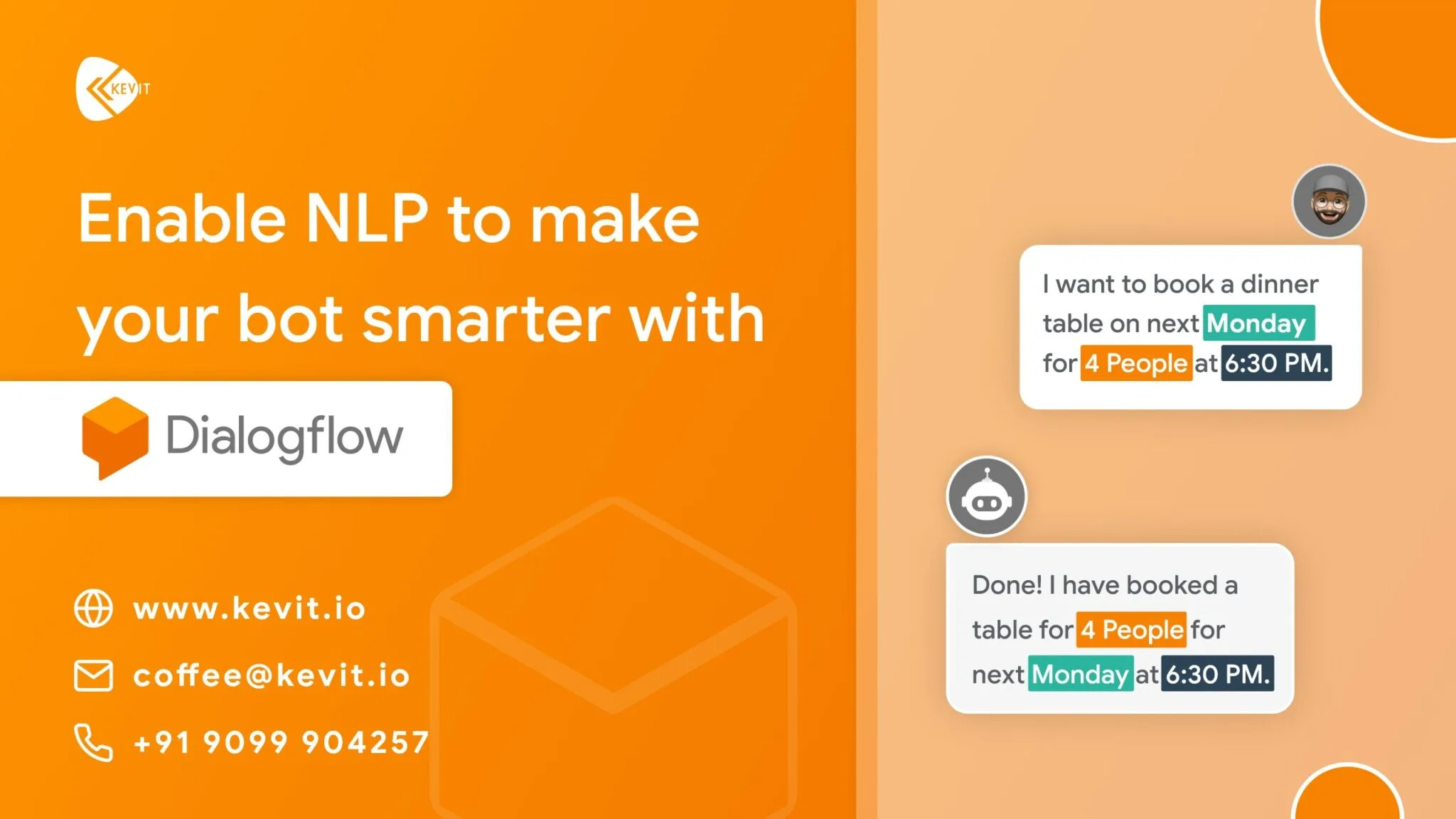Enable NLP to make your bot smarter with Dialogflow

- April 12, 2021
- Priyanka Shah
- Conversational AI, Engineering/ ML
What is NLP?
NLP – Natural language processing is a computer science technology powered by Artificial Intelligence which enables the interaction between computer and human in natural language. It can be used in the development of Chatbots, IVRs, Robots, and more to process user’s input in the form of natural language. For example, with the help of NLP Siri, Alexa and Google Home can understand what you are saying and what they have to reply.
Why your chatbot need NLP?
NLP is an important element of your chatbot that allows it to interpret user’s text or voice inputs. Without NLP, your chatbot can work only on a flow-based manner. That means the chatbot will drive user in a certain direction without understanding user’s actual needs and requirements. This can irritate your users and leading them somewhere without their interest will return you with zero value. Your chatbot won’t be able to understand user’s context without NLP.
Natural Language Processing provide context and meaning to user inputs so that your chatbot can come up with the best response. So, in a way NLP helps the chatbot to leverage the AI abilities and come up with a satisfactory response.
What is Dialogflow?
According to Wikipedia, Dialogflow is a natural language understanding platform used to design and integrate a conversational user interface into mobile apps, web applications, devices, bots, interactive voice response systems and related uses.
It helps you easily create conversational user interface according to your use cases. Dialogflow can examine and understand multiple types of input from your users, including text or audio. Basically, it makes your chatbot learn the natural language.
Dialogflow Terms
Here are the terms of Dialogflow which will help you make understand how Dialogflow can make a difference in your Chatbot.
1. Agents
A Dialogflow agent is a virtual agent which handles end to end conversations with users. It understands the user’s responses, find the context and send the best matched response.
2. Intent
As per the name, Intent identifies user’s intention by their input and select the best matched result. An intent can have two types of responses. You can set response as Text or you can also set the response in JSON format.
3. Entity
Entity is basically a collection of common type of data. For example, the collection of dates, times, cities, colors, etc. Dialogflow has some pre-build system entities. You can create your own custom entities as per your requirements.
4. Training Phrase
Training phrases are the expression of your user or we can say it’s an example of what your user might say or type. When an end-user expression resembles one of these phrases, Dialogflow matches the intent.
5. Context
Dialogflow contexts are same as natural language context. There are two types of context – Input context and Output context. As per Dialogflow,
Output contexts control active contexts. When an intent is matched, any configured output contexts for that intent become active.
Input contexts control intent matching. While contexts are active, Dialogflow is more likely to match intents that are configured with input contexts that are a subset of currently active contexts.
6. Knowledge base
A knowledge base is a collection of documents that we can provide to the Dialogflow. These knowledge documents contain information that your user may say during conversation.
7. Fulfillment
With Fulfillment you can provide a more dynamic response. Dialogflow support some integrations. Using Fulfillment, you can integrate your database, Calander to update data, mark events, etc. For example, if an end-user wants to schedule an appointment on Monday, your integration service can check your database and respond to the end-user with availability information for Appointment on Monday.
Here are some other features of Dialogflow
- Small Talk
- Multi-Lingual Agent Support
- Cross Platform Support
- Training
- Agent Creation & Management
- Integrations
- In-Line Code Editor
- Analytics
Benefits of Dialogflow
- Import and export of chat agents.
- Multiple languages are supported. Currently, Dialogflow support speech-to-text capabilities in 32 languages and text-to-speech capabilities in 28 languages, and Google Translate supports translation between 104 languages.
- Context-based input recognition to understand user’s need deeply.
- Comprehensive error reporting which leads help you with error management.
- When it comes to google, you will always get some great analytics report for deeper insights.
- Third party Integrations and webhook integrations to manage and update your database to serve your customers with real time data.
- One agent can be used in multiple chatbots/projects.
- Dialogflow Standard Edition is free, there are limits on the number of requests that you can make.
Compared to other NLP providers or Chatbot development platforms, Dialogflow is much advanced and has many advantages. We are developing Dialogflow chatbot since it was introduced. Feel free to contact Kebvit.io to take advantages of our Dialogflow expertise for your chatbot development needs or email your requirement at coffee@kevit.io or visit us at Kevit.io.
See Kevit.io In Action
Automating business processes with Kevit.io is now just a click away!